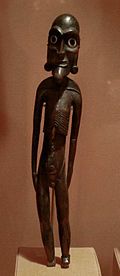Moai kavakava

A mo‘ai kavakava is a small wooden figure of a style originated by the Rapa Nui culture of Easter Island.
Each figure resembles a standing, slightly stooped, male human with an emaciated body.
The name mo‘ai kavakava is formed from mo‘ai for the monumental monolithic human figures found on Easter Island and the word kavakava meaning ribs. Little is known about the cultural context of these figures although they are generally considered to be representations of starving ancestors or demons. It is believed[by whom?] these figures were worn hanging around the necks of men who took part in the ritual dances during public ceremonies.[1]
German Expressionist Max Ernst was inspired by these figures and their rituals. The figures can also be found in the collections of the French surrealist André Breton.[citation needed]
References
- ^ Forment, F.; Huyge, D.; Valladas, H. (September 2001). "AMS 14C age determinations of Rapanui (Easter Island) wood sculpture: moai kavakava ET 48.63 from Brussels". Antiquity. 75 (289): 529–532. Archived from the original on October 8, 2016. Retrieved September 12, 2016.
External links
- Splendid Isolation: Art of Easter Island, an exhibition catalog from The Metropolitan Museum of Art (fully available online as PDF), which contains material on Moai kavakava
- Images of Moai kavakava in the collection of the Museum of New Zealand Te Papa Tongarewa
- Image of Moai kavakava in the collection of the Vatican
